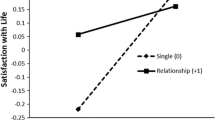Abstract
We examined body objectification, self-esteem, and relationship satisfaction differences between college women and exotic dancers and the relationships among these measures for both groups. Forty-three college women and 40 female exotic dancers completed a questionnaire that assessed each of these constructs. Relative to college women, exotic dancers reported less relationship satisfaction, more body surveillance, and a greater prioritizing of body attractiveness over physical competence. Relationship satisfaction and the prioritizing of appearance over physical competence varied for the heterosexual and bisexual dancers. For exotic dancers, the body objectification measures of surveillance and shame were negatively, and body control was positively, related to self-esteem; body shame was negatively related to relationship satisfaction. For college women, higher levels of body surveillance and body shame were associated with higher prioritizing of physical attractiveness relative to physical competence.
Similar content being viewed by others
References
Akan, G. E., & Grilo, C. M. (1995). Sociocultural influences on eating attitudes and behaviors, body image, and psychological functioning: A comparison of African American, Asian American, and Caucasian college women. International Journal of Eating Disorders, 18, 181–187.
Barton, B. (2002). Dancing on the Mobius strip: Challenging the sex war paradigm. Gender and Society, 16, 585–602.
Bernard, C., DeGabrielle, C., Cartier, L., Monk-Turner, E., Phill, C., Sherwood, J., et al. (2003). Exotic dancers: Gender differences in societal reaction, subcultural ties, and conventional support. Journal of Criminal Justice and Popular Culture, 10(1), 1–11.
Cushman, C. (2000). Stop pretending. Retrieved September 5, 2004, from http://www.Connectionmagazine.org/archives_old2000/stoppretend.htm.
Eaves, E. (2002). Bare: The naked truth about stripping. Emeryville, CA: Seal.
Fredrickson, B. L., & Noll, S. M. (1998). A mediation model linking self-objectification, body shame, and disordered eating. Psychology of Women Quarterly, 22, 623–636.
Fredrickson, B. L., & Roberts, T.-A. (1997). Objectification theory. Psychology of Women Quarterly, 21, 173–206.
Fredrickson, B. L., Roberts, T., Noll, S. M., Quinn, D. M., & Twenge, J. M. (1998). That swimsuit becomes you: Sex differences in self-objectification, restricted eating, and math performance. Journal of Personality and Social Psychology, 75, 269–284.
Friday, N. (1999). Our looks/our lives: Sex, beauty, power, and the need to be seen. New York: Harper-Collins.
Gilman, S. J. (2003). Klaus Barbie, and other dolls I’d like to see. In O. Edut (Ed.), Body outlaws: Rewriting the rules of beauty and body image (pp. 14–21). Emeryville, CA: Seal.
Hendrick, S. S. (1998). A generic measure of relationship satisfaction. Journal of Marriage and the Family, 50, 93–98.
Lewis, J. (1998). Learning to strip: The socialization experiences of exotic dancers. Canadian Journal of Human Sexuality, 7, 51–66.
Lewis, J., & Maticka-Tyndale, E. (2000). Licensing sex work: Public policy and women’s lives. Canadian Public Policy, 26, 437–449.
McKinley, N. M. (1998). Gender differences in undergraduates’ body esteem: The mediating effect of objectified body consciousness and actual/ideal weight discrepancy. Sex Roles, 39, 113–123.
McKinley, N. M. (1999). Women and objectified body consciousness: Mothers’ and daughters’ body experience in cultural, developmental, and familial context. Developmental Psychology, 35, 760–769.
McKinley, N. M., & Hyde, J. S. (1996). The objectified body consciousness scale. Psychology of Women Quarterly, 20, 181–215.
Muehlenkamp, J. J., & Saris-Baglama, R. N. (2002). Self-objectification and its psychological outcomes for college women. Psychology of Women, 26, 371–379.
Murnen, S. K., Smolak, L., Mills, J. A., & Good, L. (2003). Thin sexy women and strong, muscular men: Grade-school children’s responses to objectified images of women and men. Sex Roles, 49, 427–437.
Nagel, K. L., & Jones, K. H. (1992). Sociological factors in the development of eating disorders. Adolescence, 27, 107–113.
Nolen-Hoeksema, S., & Girgus, J. S. (1994). Emergence of gender differences in depression during adolescence. Psychological Bulletin, 115, 424–444.
Noll, S. M., & Fredrickson B. L. (1998). A mediational model linking self-objectification, body shame, and disordered eating. Psychology of Women Quarterly, 22, 623–636.
Parsons, E. M., & Betz, N. E. (2001). The relationship of participation in sports and physical activity to body objectification, instrumentality, and locus of control among young women. Psychology of Women Quarterly, 25, 209–222.
Prichard, I., & Tiggemann, M. (2005). Objectification in fitness centers: Self-objectification, body dissatisfaction, and disordered eating in aerobic instructors and aerobic participants. Sex Roles, 53, 19–28.
Rosenberg, M. (1965). Society and the adolescent self image. Princeton, NJ: Princeton University Press.
Sundahl, D. (1987). Stripper. In F. Delacoste & P. Alenander (Eds.), Sex work: Writings by women in the sex industry (pp. 175–180). Pittsburgh: Cleis.
Tiggemann, M. (2001). The impact of adolescent girls’ life concerns and leisure activities on body dissatisfaction, disordered eating, and self-esteem. Journal of Genetic Psychology, 162, 133–142.
Tiggemann, M., & Kuring, J. K. (2004a). The role of body objectification in disorder eating and depressed mood. British Journal of Clinical Psychology, 43, 311–399.
Tiggemann, M. & Kuring, J. K. (2004b). The role of body objectification in disordered eating and depressed mood. British Journal of Clinical Psychology, 43, 299–311.
Tiggemann, M., & Slater, A. (2001). A test of objectification theory in former dancers and non-Dancers. Psychology of Women Quarterly, 25, 57–64.
Tisdale, S. (1995). A weight that women carry. In P. Foster (Ed.), Minding the body: Women writers on body and soul (pp. 15–31). New York: First Anchor.
Wright, C. I., & Busby, D. M. (1997). Relationship satisfaction: Impact and consequences for women’s emotional health and treatment. Contemporary Family Therapy: An International Review, 19, 443–461.
Author information
Authors and Affiliations
Corresponding author
Rights and permissions
About this article
Cite this article
Downs, D.M., James, S. & Cowan, G. Body Objectification, Self-Esteem, and Relationship Satisfaction: A Comparison of Exotic Dancers and College Women. Sex Roles 54, 745–752 (2006). https://doi.org/10.1007/s11199-006-9042-y
Published:
Issue Date:
DOI: https://doi.org/10.1007/s11199-006-9042-y



